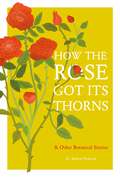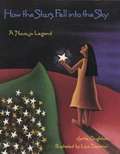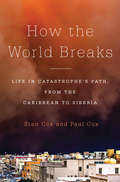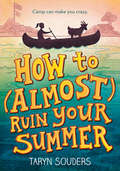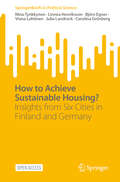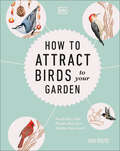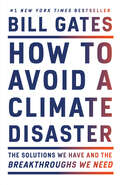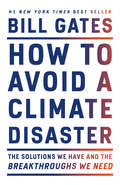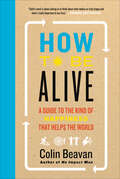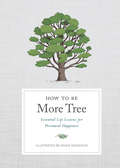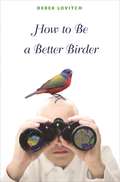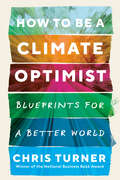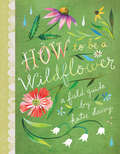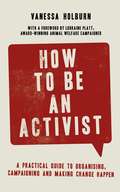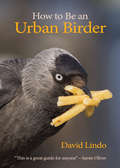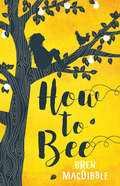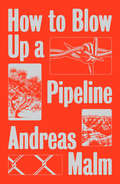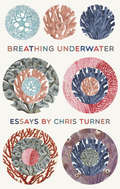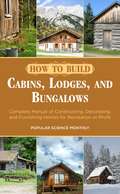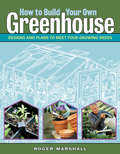- Table View
- List View
How the Rose Got Its Thorns: And Other Botanical Stories
by Dr Andrew OrmerodHave you ever wondered why the rose has thorns and other flowers don't; why the daffodil is the colour it is; or why some plants have shiny leaves and others matt?How The Rose Got its Thorns reveals the inner workings of our favourite flowers and trees. Designed to help gardeners, both novice and experienced, better understand how plants grow, the book is easy to navigate - it is divided into 50 chapters, each one a story.Accompanied by specially commissioned colour illustrations, each chapter explains the science behind how plants work and the extraordinary processes they have evolved: such as protecting themselves from predators using chemicals; attracting pollinators using scent, shape and colour; growing in low or high temperatures; their relationship with the wind; the size and pattern of their leaves; the distribution of their seeds and survival strategies; their relationship with insects; how they allocate their resources; and how they retain water efficiently.This delightful and intriguing book offers readers an accessible way to better understand how our plants evolved into the species of today.
How the Rose Got Its Thorns: And Other Botanical Stories
by Dr Andrew OrmerodHave you ever wondered why the rose has thorns and other flowers don't; why the daffodil is the colour it is; or why some plants have shiny leaves and others matt?How The Rose Got its Thorns reveals the inner workings of our favourite flowers and trees. Designed to help gardeners, both novice and experienced, better understand how plants grow, the book is easy to navigate - it is divided into 50 chapters, each one a story.Accompanied by specially commissioned colour illustrations, each chapter explains the science behind how plants work and the extraordinary processes they have evolved: such as protecting themselves from predators using chemicals; attracting pollinators using scent, shape and colour; growing in low or high temperatures; their relationship with the wind; the size and pattern of their leaves; the distribution of their seeds and survival strategies; their relationship with insects; how they allocate their resources; and how they retain water efficiently.This delightful and intriguing book offers readers an accessible way to better understand how our plants evolved into the species of today.
How the Stars Fell into the Sky: A Navajo Legend
by Lisa Desimini Jerrie OughtonThis retelling of a Navajo folktale explains how First Woman tried to write the laws of the land using stars in the sky, only to be thwarted by the trickster Coyote.
How the World Breaks: Life in Catastrophe's Path, from the Caribbean to Siberia
by Stan Cox Paul CoxWe've always lived on a dangerous planet, but its disasters aren't what they used to be. How the World Breaks gives us a breathtaking new view of crisis and recovery on the unstable landscapes of the Earth's hazard zones. Father and son authors Stan and Paul Cox take us to the explosive fire fronts of overheated Australia, the future lost city of Miami, the fights over whether and how to fortify New York City in the wake of Sandy, the Indonesian mud volcano triggered by natural gas drilling, and other communities that are reimagining their lives after quakes, superstorms, tornadoes, and landslides.In the very decade when we should be rushing to heal the atmosphere and address the enormous inequalities of risk, a strange idea has taken hold of global disaster policy: resilience. Its proponents say that threatened communities must simply learn the art of resilience, adapt to risk, and thereby survive. This doctrine obscures the human hand in creating disasters and requires the planet's most beleaguered people to absorb the rush of floodwaters and the crush of landslides, freeing the world economy to go on undisturbed. The Coxes' great contribution is to pull the disaster debate out of the realm of theory and into the muck and ash of the world's broken places. There we learn that change is more than mere adaptation and life is more than mere survival. Ultimately, How the World Breaks reveals why--unless we address the social, ecological, and economic roots of disaster--millions more people every year will find themselves spiraling into misery. It is essential reading for our time.
How to (Almost) Ruin Your Summer
by Taryn SoudersTop Three Reasons Camp Minnehaha is The Worst1. The spiders (wayyyy too many legs)2. King Arthur (a rampaging goat intent on my destruction)3. Victoria a.k.a The Diva (an evil cabin mate obsessed with French beauty products and my humiliation)Chloe McCorkle knew a summer camp where you had to learn a career was a bad idea. She tried to tell her parents, but they just had to go on vacation to Alaska and ship her off for two weeks. It's not ideal, but she's going to try to make the best of it. She might even learn some skills that will help her make money for the new bike she's been eyeing. But Chloe quickly discovers there's only one area at which she excels; she manages to get more demerits than anyone else in camp...
How to Achieve Sustainable Housing?: Insights from Six Cities in Finland and Germany (SpringerBriefs in Political Science)
by Björn Egner Nina Tynkkynen Linnéa Henriksson Viena Lahtinen Julia Landrock Carolina GrönbergThis Brief provides an integrated study of housing and climate policy at the local level. Drawing from an empirical research project across six cities in Finland and Germany, the book explores the degree of integration between housing and climate policy in local government, specifically focusing on the level of awareness of local politicians of the interdependency of the two policy areas. Using document analysis as well as extensive interviews with local politicians, the Brief explains which views local councillors hold about the responsibilities of their municipality in housing and climate policy, how the two fields influence each other and what councillors see as obstacles for joint decision making in both fields. The book looks at housing from a broader perspective, linking housing not only to the number of dwellings, zoning, or construction, but also to the environment, communities and transport. Offering policy advice on how to integrate these sectors and pursue sustainable housing from a holistic perspective, this Brief will be of use to researchers and policymakers interested in housing policy, climate policy, local politics, urban politics, and sustainability. This book is open access, which means that you have free and unlimited access.
How to Attract Birds to Your Garden: Foods they like, plants they love, shelter they need
by Dan RouseHelp your local wild birds by providing them with a safe garden environmentMake a difference to your local birdlife. Help reverse the decline in bird numbers by creating a haven in which they will thrive. It's a win-win. Provide the best shelter, feeding, and nesting opportunities for them and then you can reap the rewards as they sing and entertain.No need to be an expert gardener already, or to break the bank - many of the most beneficial features can be installed easily and cheaply, and many you can build yourself or upcycle to be eco-friendly.
How to Avoid a Climate Disaster: The Solutions We Have and the Breakthroughs We Need
by Bill GatesIn this urgent, singularly authoritative book, Bill Gates sets out a wide-ranging, practical--and accessible--plan for how the world can get to zero greenhouse gas emissions in time to avoid an irreversibleclimate catastrophe.Bill Gates has spent a decade investigating the causes and effects of climate change. With the help and guidance of experts in the fields of physics, chemistry, biology, engineering, political science and finance, he has focused on exactly what must be done in order to stop the planet's slide toward certain environmental disaster. In this book, he not only gathers together all the information we need to fully grasp how important it is that we work towardnet-zero emissions of greenhouse gases but also details exactly what we need to do to achieve this profoundly important goal. He gives us a clear-eyed description of the challenges we face. He describes the areas in which technology is already helping to reduce emissions; where and how the current technology can be made to function more effectively; where breakthrough technologies are needed, and who is working on these essential innovations. Finally, he lays out a concrete plan for achieving the goal of zero emissions--suggesting not only policies that governments should adopt, but what we as individuals can do to keep our government, our employers and ourselves accountable in this crucial enterprise.As Bill Gates makes clear, achieving zero emissions will not be simple or easy to do, but by following the guidelines he sets out here, it is a goal firmly within our reach.
How to Avoid a Climate Disaster: The Solutions We Have and the Breakthroughs We Need
by Bill GatesIn this urgent, authoritative book, Bill Gates sets out a wide-ranging, practical--and accessible--plan for how the world can get to zero greenhouse gas emissions in time to avoid a climate catastrophe. <P><P>Bill Gates has spent a decade investigating the causes and effects of climate change. With the help of experts in the fields of physics, chemistry, biology, engineering, political science, and finance, he has focused on what must be done in order to stop the planet's slide to certain environmental disaster. In this book, he not only explains why we need to work toward net-zero emissions of greenhouse gases, but also details what we need to do to achieve this profoundly important goal. <P><P>He gives us a clear-eyed description of the challenges we face. Drawing on his understanding of innovation and what it takes to get new ideas into the market, he describes the areas in which technology is already helping to reduce emissions, where and how the current technology can be made to function more effectively, where breakthrough technologies are needed, and who is working on these essential innovations. Finally, he lays out a concrete, practical plan for achieving the goal of zero emissions--suggesting not only policies that governments should adopt, but what we as individuals can do to keep our government, our employers, and ourselves accountable in this crucial enterprise. <P><P>As Bill Gates makes clear, achieving zero emissions will not be simple or easy to do, but if we follow the plan he sets out here, it is a goal firmly within our reach. <P><P><b>A New York Times Bestseller</b>
How to Be Alive: A Guide to the Kind of Happiness That Helps the World
by Colin Beavan“This is the book where self-help turns into helping the world—and then turns back into helping yourself find a better life. Fascinating and timely!”—Bill McKibben, author of Eaarth: Making a Life on a Tough New PlanetWhat does it take to achieve a successful and satisfying life? Not long ago, the answer seemed as simple as following a straightforward path: college, career, house, marriage, kids, and a secure retirement. Not anymore. Staggering student loan debt, sweeping job shortages, a chronically ailing economy—plus the larger issues of global unrest, poverty, and our imperiled environment—make the search for fulfillment more challenging. And, as Colin Beavan, activist and author of No Impact Man, proclaims, more exciting.In this breakthrough book, Beavan extends a hand to those seeking more meaning and joy in life even as they engage in addressing our various world crises. How to Be Alive nudges the unfulfilled toward creating their own version of the Good Life—a life where feeling good and doing good intersect. He urges readers to reexamine the “standard life approaches” to pretty much everything and to experiment with life choices that are truer to their values, passions, and concerns.How do you stop placing limits on your potential impact? How do you make your choices really matter in everything from your clothing purchases to your career? How do you find the people who will most support you in your quest for a good life? To answer these questions and more, Beavan draws on classic literature and philosophy; surprising new scientific findings; and the uplifting personal stories of real-life “lifequesters”—people who are breaking away from those old broken paths, blazing fresh trails, and reveling in every step along the way.“There is a movement afoot for a better life and Colin Beavan is its prophet, with a new book as powerful as his already classic No Impact Man.”—John de Graaf, coauthor of Affluenza
How to Be More Tree: Essential Life Lessons for Perennial Happiness
by Potter GiftA beautifully illustrated celebration of the wisdom of trees and what they can teach us about everyday life, from basking in the sun to weathering the storm.This sweet and informative book brings together fifty-nine universal life lessons taken from the infinite wisdom of trees. As you learn about dozens of trees, from the Acai palm to the Yoshino cherry, you'll find that their means of survival are not so different from ours. The juniper tree proves that it's possible to flourish anywhere as long as we put down strong roots. A mountain hemlock finds strength basking in the sun while a black walnut's sturdiness comes from its thick, steely core. The hawthorn demonstrates resilience as it adapts to strong winds and storms by finding balance in its roots. Trees have many more lessons to offer, from letting go of the past, to branching out, to resisting the urge to overstretch ourselves. With detailed illustrations and advice for lifelong happiness, How to Be More Tree is an essential companion for all those moments when we're having trouble seeing the forest for the trees.
How to Be a Better Birder
by Derek LovitchThe essential tools you need to become a better birderThis unique illustrated handbook provides all the essential tools you need to become a better birder. Here Derek Lovitch offers a more effective way to go about identification—he calls it the "Whole Bird and More" approach—that will enable you to identify more birds, more quickly, more of the time. He demonstrates how to use geography and an understanding of habitats, ecology, and even the weather to enrich your birding experience and help you find something out of the ordinary. Lovitch shows how to track nocturnal migrants using radar, collect data for bird conservation, discover exciting rarities, develop patch lists—and much more.This is the ideal resource for intermediate and advanced birders. Whether you want to build a bigger list or simply learn more about birds, How to Be a Better Birder will take your birding skills to the next level.Explains the "Whole Bird and More" approach to bird identificationDemonstrates how to use geography, habitats, ecology, and the weather to be a better birderShows how to bird at night using radar, collect conservation data, develop patch lists—and moreOffers essential tools for intermediate and advanced birders
How to Be a Climate Optimist: Blueprints for a Better World
by Chris TurnerFrom the National Business Book Award winner and GG finalist, a very different book about facing the climate crisis, and what awaits us on the other side.Chris Turner has reported from the places where the sustainable future first emerged—from green islands in Denmark and green office parks in southern India, to solar panel factories in California and idealistic intentional communities from Scotland to New Mexico. Here, he condenses the first quarter century of the global energy transition into bite-sized chunks of optimistic reflection and reportage, telling a story of a planet in peril and a global effort already beginning to save it. This is a book that moves past the despair and futile anger over ecological collapse and harnesses that passion toward the project of building a twenty-first century quality of life that surpasses the twentieth-century version in every way. How to Be a Climate Optimist overflows with possibility in a moment of great panic, upheaval and uncertainty over a world on fire.
How to Be a Cloud Spotter (Fountas & Pinnell Classroom)
by Jane GerverHeads Up! We're used to seeing clouds in the sky: high clouds, low clouds, thin or fluffy clouds, dark or white clouds. But there's much more to know about clouds and the part they play in our lives. NIMAC-sourced textbook
How to Be a Moonflower
by Katie DaisyHow to Be a Moonflower, the new book from bestselling author Katie Daisy, celebrates the magic and mystery of the world at night.Discover the world that awakens after everyone else has gone to sleep. In this lavishly illustrated book, New York Times–bestselling artist Katie Daisy explores the mystery and magic of the nighttime. Join her on a journey from dawn to dusk, complete with quotes, poems, meditations, field guides to different nocturnal flora and fauna, and charts that map out the cosmos. From night-blooming flowers to cozy campfires, from moon baths to meteor showers, Katie Daisy's lush illustrations capture the beauty that comes to life in the darkness.BELOVED AUTHOR: Known for her lush, painterly artwork and love of the natural world, NEW YORK TIMES–bestselling author Katie Daisy has 112K followers on Instagram, where you will find frequent posts featuring her vibrant illustrations.A CELEBRATION OF NATURE: Nature-lovers and plant-appreciators will find much to admire in this book. Illustrating everything from the phases of the moon to fluttering moths, Katie Daisy has a knack for capturing the very best this magical world has to offer.EXPLORE THE WONDERS OF NIGHT TIME: The nighttime offers time for reflection, exploration, and adventure. This book will help you make the most of those mystical, after-dark hours and observe the hidden wonders that come to life at nightDELUXE PACKAGE: Featuring a tactile two-piece case with silver metallic ink on the spine and back cover, How to Be a Moonflower makes a beautiful gift for the people in your life who look to art and illustration for creative encouragement, self-exploration, and mindfulness.Perfect for:• Fans of Katie Daisy's artwork and previous book HOW TO BE A WILDFLOWER• free spirits• art and nature lovers• tarot readers and moon worshippers
How to Be a Wildflower: A Field Guide
by Katie DaisyA field guide to finding calm, creativity, and self-discovery through encounters with nature. A fresh perspective, an outdoor exploration, a new adventure about to begin—How to Be A Wildflower is a book for celebrating these and other wide-open occasions. Encouraging self-discovery through encounters with nature, beloved artist Katie Daisy brings her beautiful paintings and lettering to this collection of things to do and make, quotes, meditations, natural history, and more.Find wonder and inspiration in these peaceful pages, live life to the fullest, and discover the wild and free spirit within. “For pure whimsy, you just can’t beat How to Be a Wildflower: A Field Guide by Katie Daisy. The Bend, Oregon, artist brings her beautiful paintings and lettering to this delightful book, a collection of nature-inspired quotations, meditations, lore, and even a recipe for fresh strawberry-rhubarb pie.” —Traditional Home
How to Be a Witch
by Gabrielle Balkan Shana GozanskyA witch-themed picture book unlike any other – it&’s nonfiction!Most people, kids included, have very specific associations with &“witch&” – perhaps a scheming, warted, and/or green-faced woman in a pointy hat and heels, brewing a potion with gruesome ingredients intended for harm or dark magic. And though witches are real, none of that is actually true! Over many centuries, knowledgeable, powerful, and healing women have been demonized by men who fear a loss of power or pride. And through those same centuries, certain people have passed down their lived and learned knowledge of nature&’s power to heal. Those who identify as witches today are most often natural healers whose wisdom serves to help those around them.Written in a conversational, engaging tone, and illustrated in an accessible and appealing style, this book dispels stereotypes and expands young readers&’ knowledge of what it means to be a REAL witch. Complete with a suggested potion and spell in the backmatter, this is a current and worthy celebration of witches!
How to Be an Activist: A practical guide to organising, campaigning and making change happen
by Vanessa HolburnFrom experienced campaigner Vanessa Holburn and with a foreword by award-winning animal welfare campaigner Lorraine Platt, this is the essential guide to activism. 'Essential reading for anyone looking to start a grassroots campaign - and useful bedtime reading for some of our political parties too' - Hannah Beckerman, GuardianHow To Be an Activist covers everything you need to know to create a successful social campaign and bring about positive change no matter what your cause. This practical, inspirational book covers topics ranging from identifying your central issue and setting meaningful milestones and goals, to learning how to use the media effectively and stay safe and within the law. It will help you with every step of your campaign, keeping you motivated through periods of self-doubt and staving off burnout as you celebrate milestones on the way to creating meaningful change in the world. With contributions from influential campaigners including Natasha Devon MBE.Fresh from waving banners in the pouring rain, journalist and campaigner Vanessa Holburn passes on the lessons she has learned so the reader can fast track their movement to success. This is the age of activism and everyone is invited to join the movement.
How to Be an Activist: A practical guide to organising, campaigning and making change happen
by Vanessa HolburnFrom experienced campaigner Vanessa Holburn and with a foreword by award-winning animal welfare campaigner Lorraine Platt, this is the essential guide to activism. 'Essential reading for anyone looking to start a grassroots campaign - and useful bedtime reading for some of our political parties too' - Hannah Beckerman, GuardianHow To Be an Activist covers everything you need to know to create a successful social campaign and bring about positive change no matter what your cause. This practical, inspirational book covers topics ranging from identifying your central issue and setting meaningful milestones and goals, to learning how to use the media effectively and stay safe and within the law. It will help you with every step of your campaign, keeping you motivated through periods of self-doubt and staving off burnout as you celebrate milestones on the way to creating meaningful change in the world. With contributions from influential campaigners including Natasha Devon MBE.Fresh from waving banners in the pouring rain, journalist and campaigner Vanessa Holburn passes on the lessons she has learned so the reader can fast track their movement to success. This is the age of activism and everyone is invited to join the movement.
How to Be an Urban Birder (Wildguides Ser. #13)
by Jamie Oliver David LindoThe first guide to urban birding in the UK, from The Urban Birder himself, David LindoUrban birding is fast becoming ornithology’s new rock ’n’ roll. Birds and birding have never been cooler—and urban birding is at the cutting edge.How to Be an Urban Birder is the world’s first guide to the art of urban birding—which is so easy and great fun! Here, urban birding pioneer David Lindo tells you everything you need to know about birds and birding in towns and cities in the UK.Includes a brief history of urban birding in the UKCovers the best places to look for birds in towns and citiesHelps you get to know your urban birdsGives useful tips on how to attract birds to your gardenExplains what gear you need and how to go about being an urban birderFeatures hundreds of cool images and illustrations of birds in urban settings
How to Bee
by Bren MacDibbleA story about family, loyalty, kindness and bravery, set against an all-too-possible future where climate change has forever changed the way we live. In a world where real bees are extinct, the quickest, bravest kids climb the fruit trees and pollinate the flowers by hand. Peony lives with her sister, Magnolia, and her grandfather on a fruit farm outside the city. All Peony really wants is to be a bee. Even though she is only nine — and bees must be ten — Peony already knows all there is to know about being a bee and she is determined to achieve her dream. Life on the farm is a scrabble, but there is enough to eat and a place to sleep, and there is love. Then Peony’s mother arrives to take her away from everything she has ever known. Peony is taken to the city to work for a wealthy family. Will Peony’s grit and quick thinking be enough to keep her safe? How to Bee is a beautiful and fierce novel for younger readers, and the voice of Peony will stay with you long after you read the last page. Correlates to the Common Core State Standards in English Language Arts: CCSS.ELA-LITERACY.RL.5.6 Describe how a narrator's or speaker's point of view influences how events are described.
How to Blow Up a Pipeline
by Andreas MalmProperty will cost us the earthThe science on climate change has been clear for a very long time now. Yet despite decades of appeals, mass street protests, petition campaigns, and peaceful demonstrations, we are still facing a booming fossil fuel industry, rising seas, rising emission levels, and a rising temperature. With the stakes so high, why haven't we moved beyond peaceful protest?In this lyrical manifesto, noted climate scholar (and saboteur of SUV tires and coal mines) Andreas Malm makes an impassioned call for the climate movement to escalate its tactics in the face of ecological collapse. We need, he argues, to force fossil fuel extraction to stop--with our actions, with our bodies, and by defusing and destroying its tools. We need, in short, to start blowing up some oil pipelines.Offering a counter-history of how mass popular change has occurred, from the democratic revolutions overthrowing dictators to the movement against apartheid and for women's suffrage, Malm argues that the strategic acceptance of property destruction and violence has been the only route for revolutionary change. In a braided narrative that moves from the forests of Germany and the streets of London to the deserts of Iraq, Malm offers us an incisive discussion of the politics and ethics of pacifism and violence, democracy and social change, strategy and tactics, and a movement compelled by both the heart and the mind. Here is how we fight in a world on fire.
How to Breathe Underwater
by Chris TurnerThe essays and reportage in How to Breathe Underwater offer a panoramic overview of this age of radical change-from the online gambling boom in the Caribbean to Cyberjaya, the Malaysian government's attempt to build its own Silicon Valley; from video game design to digital-age tabloid journalism to the artistry of The Simpsons; and from the fate of the Great Barrier Reef to Cuba's economic limbo after the fall of the Soviet empire. In field reports that survey the rise of the internet in the 1990s, analyze the changing nature of mass culture in the digital age, and provide a multifaceted look at how human industry is shaping the planet's foundations, this collection presents a fractal portrait of a society in rapid flux. Chris Turner is the author of four previous books, a nine-time National Magazine Award winner and a sought-after speaker on the rise of the global green economy, as well as a celebrated feature writer for The Walrus, Canadian Geographic, The Globe & Mail and other major publications. His lively and passionate reportage, along with his incisive essays and shrewd cultural criticism, have for the past fifteen years made essential contributions to the debates on our climate, culture, and technology. They are collected here for the first time.Praise for How To Breathe Underwater"Chris Turner is among the best magazine writers on the planet. His writing is so beautiful, wry and well-reported that it's spellbinding. And spellbreaking: He wakes you up, makes you sit upright and look afresh at our culture, our climate, and where we need to go. This is literary nonfiction at its finest."-Clive Thompson, Wired columnist and author of Smarter Than You Think"Chris Turner is the master of long-form journalism in Canada, a smart, funny, and endlessly curious envoy to everywhere. This collection gathers his best work, forging links of meaning in a chain of superb reporting and writing; readers will see many choice pieces and realize, maybe for the first time, that they were all fashioned by the same indefatigable intelligence."-Mark Kingwell, the author of A Civil Tongue"Whatever you choose to call this kind of stylishly reported, deeply engaged, richly nuanced, gorgeously written nonfiction--saturation reportage, new journalism, longform writing--it without question qualifies as real literature. It's the only kind of journalism that gets remembered, and the only kind that produces real change. Chris Turner has been writing it since he started taking notes."-Ian Brown, author of The Boy in the Moon and Globe & Mail feature writer
How to Build Cabins, Lodges, and Bungalows: Complete Manual of Constructing, Decorating, and Furnishing Homes for Recreation or Profit
by Popular Science MonthlyMany generations ago, the cabin was the backbone of American life; it was the headquarters of that important unit-the home. It provided shelter, protection, and a foundation upon which to build a great empire. The pioneer cabin, understandably, was a necessity.Even in today's modern and complex world, many people still reside in cabins built to withstand permanent housing. In addition, cabins that serve as hunting and fishing lodges, summer cottages, and bungalows are seen as recreational luxuries. Cabins are healthy investments-when built correctly and cared for continuously, that is.Originally published in 1934, How to Build Cabins, Lodges, and Bungalows is both a historical and practical text that offers step-by-step instructions on how to build these structures and their various components: doors, windows, shutters, fireplaces, chimneys, porches, and more.In addition to shedding light on how cabins, lodges, bungalows-and even wayside stands and tourist homes-are built, the editors of Popular Science Monthly also included ideas for furnishing and decorating the finished homes and lodges, along with suggested lands on which to build them and tips on how to finance them.
How to Build Your Own Greenhouse: Designs and Plans to Meet Your Growing Needs
by Roger MarshallUnlock new growing opportunities and increase your property value with an outdoor conservatory. In this illustrated guide, Roger Marshall shows you how to build our own greenhouse using simple, easy-to-follow techniques. Covering everything from selecting a site to glazing glass, Marshall includes tips on laying a foundation, construction materials, ventilation, and much more. Whether your goal is to stretch the growing season or create a lush space for a year-round hot tub, you can build the greenhouse of your dreams.
